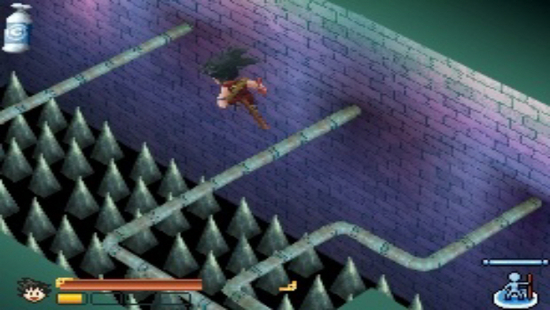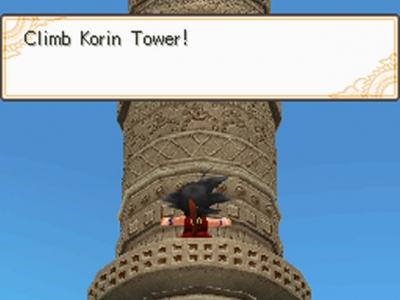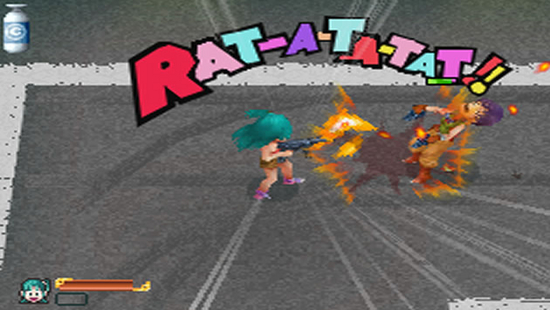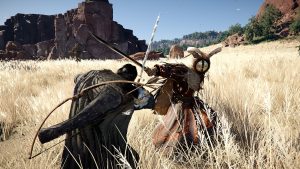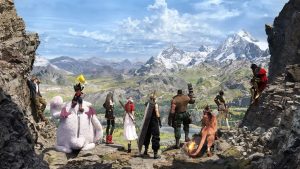Most English-speaking people know Dragon Ball because of its sequel, Dragon Ball Z. The adventures of Son Goku and his friends appeared on television and in comic stores, and in the 90’s the franchise was huge. Even now, Dragon Ball Z remains one of the more popular anime, especially since Dragon Ball Z Kai is now airing on some channels. Dragon Ball is set before Dragon Ball Z and chronicles the adventures of Goku and his friends long before they got around to flying around, blasting space aliens and wearing golden hairdos. It’s a simpler adventure story, featuring a child version of Goku as he battles the forces of evil in search of the titular Dragon Balls: seven magical stones that, when assembled together, can grant any wish. Dragon Ball: Origins 2 starts off where the previous Origins game ended. Goku has thwarted the plans of the Emperor Pilaf – a nasty little fellow who gathered all seven Dragon Balls and tried to use his wish to take over the world. While Goku and friends stopped his plan, the Dragon Balls were scattered to the corners of the world. Goku sets out in search of the 4-Star Dragon Ball, which was given to him by his grandfather. Unfortunately for him, this puts him in conflict with the Red Ribbon Army. The self-proclaimed “evilest army in the world,” the Red Ribbons are searching for the Dragon Balls for evil purposes. In order to get his grandfather’s Dragon Ball back, Goku will have to stop their evil plan. Like the first game, Dragon Ball: Origins 2 covers a chunk of the anime’s plot. There are a few bits of original content scattered around, but it’s mostly a straight adaptation.
Origins 2 is divided into a series of chapters. Once you select a chapter, you watch some lengthy cut-scenes and are then tossed into the game. Goku is a breeze to control. You can either use the stylus or the DS’ buttons to move him around and dish out attacks. The buttons are a lot easier to use, but it’s always nice to have the stylus option. Movement is very simple. To get Goku to go somewhere, you only have to walk there. Making him jump over pits or use his tail to swing from trees involves pushing in the right direction, and Goku will take care of the rest. There’s a good amount of exploration in the game, but most of the areas are very linear. If you look at the map, any area that doesn’t lead forward probably has a treasure chest to grab, making it relatively easy to find everything in the game. Some items are better hidden, but they’re an exception to the rule – although the hidden things are usually the most important to find. As for combat, Goku beats the snot out of bad guys with his fists. The Y button is a basic attack, and the X button is a strong attack. Pressing Y multiple times unleashes combo attacks, and press X ends the combo with a special finishing move. Depending on when you press X, you’ll get different finishing attacks. The B button is a rush move, which lets you dart in and damage foes at the same time, and the A button lets you dodge enemy attacks by vanishing and reappearing elsewhere. If you time your dodge for when an enemy is just about to hit you, you’ll appear behind him and be able to perform a special counterattack for massive damage. In addition to his basic fighting mode, Goku also has a Power Pole mode, which changes his attacks. The magical, extending Power Pole lets him hit enemies and objects from afar or smash broken floors that he can’t damage with his fists, but it decreases his mobility and speed. The Power Pole switches his dodge move into a Staff Twirl blocking move. Both move sets are pretty fun and easy to use, and switching between them adds variety to the game.
Of course, it wouldn’t be a Dragon Ball game if you didn’t occasionally shoot MASSIVE LASER BEAMS™ – Goku also has the ability to charge up and unleash special attack moves in each mode. The Power Pole lets him swing the staff around to damage multiple enemies at once. Regular fighting mode lets him fire off a Ki Blast to activate distant switches, but the real trump card in Goku’s arsenal is the Kamehameha energy blast. When activated, the letters “Ka” “Me” “Ha” and “Me” all begin to appear onscreen, one set at a time. As each set appears, you charge the letters to increase their power by tapping them or holding down the Y button. The more you charge, the more power is added to the attack, but overcharging it can actually weaken the attack. Once all four letter sets are charged, Goku fires off the Kamehameha blast at his unlucky foe in a brief FMV cinematic. A fully charged Kamehameha can do ridiculous damage, sometimes enough to knock out a one-fourth or more of a boss’ health. On the down side, you can only perform a Kamehameha when Goku’s Super Bar is full. Since the bar fills slowly, you’ll have to save it for especially difficult areas. One of Dragon Ball: Origin‘s biggest problems is that it’s very, very repetitive. Most of the enemies can be defeated in the same way: running up and punching them over and over. There’s little encouragement to use different moves or varying your attack strings. Goku and his friends have a varied selection of moves, but you never feel a pressure to use most of them during combat. This wouldn’t be so bad if the game had better pacing, but this is where the flaws really start to show. Many of the game’s levels are roughly twice as long as they need to be. There isn’t really any additional gameplay in the levels; you’re just pounding the same harmless enemies over and over again. Some areas can be surprisingly nasty, but you’re more likely to get tired of swarms of easily dispatched foes than you are to get frustrated by unstoppable opponents.
The boss fights are perhaps the most challenging part, and represent some of the game’s best and worst moments. As you’d expect, the majority of the fights in the game are against famous enemies from the original cartoon, mostly members of the Red Ribbon Army or their offshoots. These fights are occasionally clever. My favorite involves a battle against a wily ninja who forces you to find him in a minigame before you can fight him. Even after he calls in four of his brothers, Goku dismantles him in a few moments. Another has you freezing a rubber monster before you can hit it by knocking it toward freezing holes in the wall. However, other fights are tedious and repetitive. They involve avoiding the exceedingly simple enemy attack pattern and launching a few blows of your own during their openings. These fights involve slowly chipping away at the enemy or risking damage. What makes Origins 2 REALLY frustrating is the checkpoint system: or lack thereof. If you die in the game, that’s basically it. You must redo the entire level from scratch. If you die at the boss or at one of a row of bosses, you get the fun of replaying the long, tedious stage from the beginning. There’s no way to start over from a reasonably placed checkpoint. You can choose to leave the level with everything you collected within, which does very little to alleviate the frustration of having to redo a level. Since some of the bosses can hit very hard, this is an unforgivable design decision. A few mistakes can mean that you have to redo the entire stage again. For most people, this would be where the game stops being fun, even if you’re a Dragon Ball fan. Being forced to replay a tedious stage because the developers didn’t see fit to toss in regular checkpoints, a basic part of gaming since non-volatile memory allowed saves and replaced password generation, could make things very frustrating. It’s fortunate that the difficulty is low enough that you can often avoid this, but even having it happen once is too much.
Also, the game’s level design is a bit schizophrenic. Some of the levels are clever and fun, with simple puzzles or hidden areas. However, other stages feel like they were added to simply to pad out the game’s length. There are more than a few that feel like corridors full of enemies and a few switches. For example, early on in Muscle Tower there is a stage that amounts to fighting a few weak guys and a boss. That’s the entire stage, and no creativity or thought is given in how to make it more interesting. Later stages are more involved, but this usually results in them being overly long. There are some interesting variations, like a few times where the game becomes a short 2-D fighting game, but they’re the exception as opposed to the rule. When the game is on, it’s a lot of fun to poke around and explore. Finding hidden treasure chests is almost essential to prevent the game from becoming frustrating and you eating your DS. Dragon Ball Origins 2 has an unusual levelling mechanic. Beating up enemies and finding treasure chests earns you Training Points, which are useless on their own. You must also find Scales, which raise the maximum level of Goku’s three stats: attack damage, health and special power. If you want to level up Goku, you have to find a Scale and spend your earned Training Points on boosting his power. It’s needlessly complex and doesn’t really add much to the game. It’s a nice incentive to explore the levels, but it also heavily penalises players who don’t. This could make the game frustrating for younger players, as it means they may hit roadblocks because they wanted to beat up bad guys instead of poke around in corners. Considering the incredibly unforgiving death mechanic, this can be a problem. You also can power up Goku by finding Scrolls, which extend the number of combos he can do with an attack or increase the attack damage.
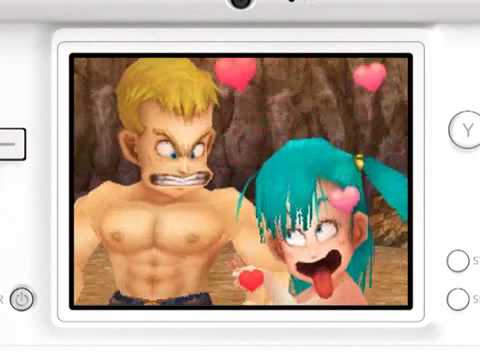
The graphics are great for the hardware and incorporate the beloved ‘wackiness’ from the franchise’s outings in other media.
The game adds some variety from time to time by allowing you to play as different characters, such as Arale, Bulma, Eighter, Krillin or Yamcha. These characters control similarly to Goku, but with a few differences. Eighter, for example, is big, beefy and brawny. This means he can’t jump over gaps like Goku can, and he certainly can’t swing by his nonexistent tail. On the other hand, he can lift big things that Goku can’t. Bulma can use her robot technology to access small areas that even the pint-sized Goku can’t. The variety in characters is a nice touch, but it doesn’t add much to the gameplay. They suffer from the same basic problems as Goku. The stages are too long, the enemy fights are too repetitive, and there’s little to alleviate the boring moments. Some of the sublevels, where you get to play as the characters, also feel poorly designed. One fight had me take the aforementioned Eighter up against a boss who would be stun-locked by his basic combo attack. It made it ridiculously easy to get an S rank on the stage because the boss wasn’t able to react to an enemy who wasn’t Goku. There’s also a “Survival Tower” Boss Rush mode where you can use various characters to fight the game’s bosses, but this isn’t very appealing, except maybe as a way to fight an enjoyable boss without having to plod through the stage.
Origins 2 does have charming graphics though: Akira Toriyama’s adorable character designs shine through, and the game is absolutely brimming with energy and life. All the characters are well-animated, and the cut scenes do a solid job of capturing popular scenes from the anime. The in-game graphics mesh very well with the Dragon Ball art style and give the entire thing a very comic book like feel, complete with POW! bubbles as you smack enemies. The music is also pretty well put-together, and there are some very catchy songs, which help to slightly lessen the tedium of replaying a chapter. While the game isn’t completely voiced, it does feature a few cut scenes that use lines directly from the dubbed version of the show. This lends extra impact to the sequences where Goku and friends actually talk. There’s also a neat set of figurines to collect, which depict various characters in various poses. They’re not much, but they add some extra gameplay, especially for fans of the franchise.
Dragon Ball: Origins 2 is a tough game to recommend. It’s clearly made for fans, but that isn’t quite enough to make me overlook its flaws. For every charming cut scene, there is an equally tedious dungeon waiting on the other side. Beating up the Red Ribbon Army or Emperor Pilaf is fun for fans, but it’s not fun enough to replay a 20-minute stage because you couldn’t dodge a boss’ attack quickly enough. If you’re a die-hard Dragon Ball fan, there is enough fan service here to keep you happy. Between playing through your favourite moments of the show and collecting tons of figurines, there’s a lot to do. Anyone else would be best off avoiding the game, as the frustrations outweigh the good points.
This game was reviewed on the Nintendo DS.
Good: more than one playable character, story conveys fun of source material, choice of control layouts.
Bad: Inadequate save-point provision, combat is shallow and repetitive, boring and overly long boss fights, limited replay value, very much one for the fans.









